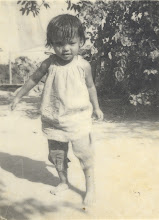
The natural Reingkhyong lake on the mountain range of upper Reingkhyong river in the Rangamati Hill District.
I have travelled to desert, world famous sea resort and to the snow-clad mountain peak. I have visited the great Tajmahal, one of the seven wonders and the Buddha Gaya, famous for being the most sacred palce for the Buddhism and also a few Indian cities. I have visited Rajasthan to see how a desert looks like and Goa, the former Portuguese colony, famous for its Arabian sea coast. I've also visited Indo-China border in Sikkim, at 17,525 feet (approx) above the sea level on the snow-clad Gurudongmar lake and Katao peak at 15,300 feet (approx). I've made my visits to these places during student years for graduation and post graduation. Of course, I'm yet to go to a foreign country beyond India. I'm confident this wish will also be fulfilled near future. And this time, I have made an 8-day long trekking programme to the beautiful mountanious eastern part of my own land.
I left Rangamati, the headquarters of the Chittagong Hill Tracts region of Bangladesh on 22nd Nov 2009 for trekking to Bangladesh-India-Myanmar tri-junction via Ruma and Reingkhyong Lake. The objectives of the trekking were to witness the way of life of the ethnic Mro, Tripura, Tanchangya and Marma peoples of mountainous eastern part of Bandarban hill district and understand their problems. Ruma bazar of Ruma Upazila was my entry point for going to this virgin part of the Chittagong Hill Tracts region.
I visited Barthali Tripura para, Barthali Marma para, Pukur para (west side of the Reingkhyong lake), Prongjang para (east side of the Reingkhyong lake) and Charging para of upper Reingkhyong reserve forest area. I found there no road network at all beyond Ruma Upazila headquarters (Sub-district) and also noticed the biggest problems were healthcare and education. The communities were completely dependent on Jum agriculture which has no sustainability.
I found 1-teacher run private schools erected by 5 communities. The salary (Tk 1,700 per month each) of the teachers is being paid by the Catholic Mission. Taungya, a Rangamati based local NGO runs 1 primary school at Barthali Tripura para with 2 teachers from the communities (Ms. Sarima Tripura, from Barthali Tripura para and Mr. Athomong Marma, from Barthali Marma para). UNDP-CHTDF covers 16 communities since 2007 through the Taungya and employed 3 health workers (Charging para, Pukur para and Barthali Tripura para) and a Community Facilitator from the communities (Ms. Malati Tripura, Ms. Rangjerung and Ms. Omathoi Tripura and the CF, Mr. Sujan Tripura).
I found worst situation in public health area which needs special care and motivation. However, I was greatly impressed to seeing their vibrant and undisturbed culture. The mountains and high hills impress the visitors but make the life of the communities harder.
Note: It will be developed later on.
I left Rangamati, the headquarters of the Chittagong Hill Tracts region of Bangladesh on 22nd Nov 2009 for trekking to Bangladesh-India-Myanmar tri-junction via Ruma and Reingkhyong Lake. The objectives of the trekking were to witness the way of life of the ethnic Mro, Tripura, Tanchangya and Marma peoples of mountainous eastern part of Bandarban hill district and understand their problems. Ruma bazar of Ruma Upazila was my entry point for going to this virgin part of the Chittagong Hill Tracts region.
I visited Barthali Tripura para, Barthali Marma para, Pukur para (west side of the Reingkhyong lake), Prongjang para (east side of the Reingkhyong lake) and Charging para of upper Reingkhyong reserve forest area. I found there no road network at all beyond Ruma Upazila headquarters (Sub-district) and also noticed the biggest problems were healthcare and education. The communities were completely dependent on Jum agriculture which has no sustainability.
I found 1-teacher run private schools erected by 5 communities. The salary (Tk 1,700 per month each) of the teachers is being paid by the Catholic Mission. Taungya, a Rangamati based local NGO runs 1 primary school at Barthali Tripura para with 2 teachers from the communities (Ms. Sarima Tripura, from Barthali Tripura para and Mr. Athomong Marma, from Barthali Marma para). UNDP-CHTDF covers 16 communities since 2007 through the Taungya and employed 3 health workers (Charging para, Pukur para and Barthali Tripura para) and a Community Facilitator from the communities (Ms. Malati Tripura, Ms. Rangjerung and Ms. Omathoi Tripura and the CF, Mr. Sujan Tripura).
I found worst situation in public health area which needs special care and motivation. However, I was greatly impressed to seeing their vibrant and undisturbed culture. The mountains and high hills impress the visitors but make the life of the communities harder.
Note: It will be developed later on.



No comments:
Post a Comment